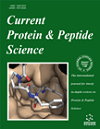- Home
- A-Z Publications
- Current Protein and Peptide Science
- Previous Issues
- Volume 19, Issue 2, 2018
Current Protein and Peptide Science - Volume 19, Issue 2, 2018
Volume 19, Issue 2, 2018
-
-
Structure, Function of Serine and Metallo-β-lactamases and their Inhibitors
More LessAuthors: Parveen Salahuddin, Amit Kumar and Asad U. KhanAntibiotic resistance in gram-negative bacteria has emerged as a major health threat that occurs because these bacteria actively produce β-lactamases responsible for the inactivation of β-lactam antibiotics. The first β lactamase was reported in E. coli back in 1940, before the release of the first antibiotic penicillin in clinical settings. Later on, large numbers of β-lactamases have been discovered in Gram-positive, Gram-n Read More
-
-
-
XBP-1, a Cellular Target for the Development of Novel Anti-viral Strategies
More LessAuthors: Han K. Ong, Benjamin P.C. Soo, Kai Ling Chu and Sheng-Hao ChaoX-box binding protein 1 (XBP-1) is a key regulator of the unfolded protein response (UPR), which is activated in response to endoplasmic reticulum (ER) stress. Cells contain two protein isoforms of XBP-1, the active isoform (XBP-1S) and the inactive isoform (XBP-1U). Induction of UPR leads to the generation of XBP-1S while XBP-1U is dominant in ER stress-free cells. XBP-1S is a transcriptional activator and regulates the expres Read More
-
-
-
Protein Tagging, Destruction and Infection
More LessAuthors: Chetana Bhaskarla, Manoj Bhosale, Pip Banerjee, Nagasuma Chandra and Dipankar NandiCells possess protein quality control mechanisms to maintain proper cellular homeostasis. In eukaryotes, the roles of the ubiquitination and proteasome-mediated degradation of cellular proteins is well established. Recent studies have elucidated protein tagging mechanisms in prokaryotes, involving transfer messenger RNA (tmRNA) and pupylation. In this review, newer insights and bioinformatics analysis of two Read More
-
-
-
RUNX1: A Regulator of NF-ΚB Signaling in Pulmonary Diseases
More LessAuthors: Xiaoju Tang, Ling Sun, Gang Wang, Bojiang Chen and Fengming LuoRunt-related transcription factor 1 (RUNX1), a member of the RUNX family, is one of the key regulatory proteins in vertebrates. RUNX1 is involved in embryonic development, hematopoiesis, angiogenesis, tumorigenesis and immune response. In the past few decades, studies mainly focused on the effect of RUNX1 on acute leukemia and cancer. Only few studies about the function of RUNX1 in the pathological process of pulmon Read More
-
-
-
Effects of Apelin Peptides on Diabetic Complications
More LessAuthors: Hong Chen, Chengyu Liu, Cheng Cheng, Ling Zheng and Kun HuangDiabetes is a metabolic disorder with multiple complications, including cardiomyopathy, retinopathy, nephropathy and neuropathy. Diabetic complications are the major cause of disability and death in diabetic patients. Apelin, a recently identified adipokine peptide, has been found to play important roles in diabetic complications. Here we summarize the current knowledge on the role of apelin in the pathogenesis of differe Read More
-
-
-
Plant Cell Wall Proteomics as a Strategy to Reveal Candidate Proteins Involved in Extracellular Lipid Metabolism
More LessAuthors: Adelaide Jacq, Vincent Burlat and Elisabeth JametPlant cell walls are composite structures surrounding cells and involved in both mechanical support and perception of their environment. They are mainly composed of polysaccharides (90-95% of their mass) and proteins (5-10%). The cell wall proteins (CWPs) contribute to the arrangements and modifications of polymer networks and to cell-to-cell communication. The structure and composition of cell walls are not uniform in Read More
-
-
-
Survey of Predictors of Propensity for Protein Production and Crystallization with Application to Predict Resolution of Crystal Structures
More LessAuthors: Jianzhao Gao, Zhonghua Wu, Gang Hu, Kui Wang, Jiangning Song, Andrzej Joachimiak and Lukasz KurganSelection of proper targets for the X-ray crystallography will benefit biological research community immensely. Several computational models were proposed to predict propensity of successful protein production and diffraction quality crystallization from protein sequences. We reviewed a comprehensive collection of 22 such predictors that were developed in the last decade. We found that almost all of these models are ea Read More
-
-
-
Cell Penetrating Peptides: A Promising Tool for the Cellular Upta ke of Macromolecular Drugs
More LessAuthors: Peipei Zhu and Lan JinThe lipid bilayer of the plasma membrane is a selective impermeable barrier for the internalization of most macromolecules. Cell penetrating peptides (CPPs) could cross the plasma membrane barrier to deliver various molecules into cells and are considered as a promising tool to deliver macromolecular drugs. However, the exact cellular uptake mechanisms of CPPs are still ambiguous. It was reported that the exact cellul Read More
-
-
-
Adipose Triglyceride Lipase Regulation: An Overview
More LessAuthors: Ines K. Cerk, Lisa Wechselberger and Monika ObererAdipose triglyceride lipase (ATGL) is the key-enzyme for the release of fatty acids (FAs) from triacylglycerol (TG) stores during intracellular lipolysis producing FAs used for energy production. There is growing evidence that the products and intermediates from lipolytic breakdown during the FA mobilization process also have fundamental regulatory functions affecting cell signaling, gene expression, metabolism, cell growth, cell Read More
-
Volumes & issues
-
Volume 26 (2025)
-
Volume 25 (2024)
-
Volume 24 (2023)
-
Volume 23 (2022)
-
Volume 22 (2021)
-
Volume 21 (2020)
-
Volume 20 (2019)
-
Volume 19 (2018)
-
Volume 18 (2017)
-
Volume 17 (2016)
-
Volume 16 (2015)
-
Volume 15 (2014)
-
Volume 14 (2013)
-
Volume 13 (2012)
-
Volume 12 (2011)
-
Volume 11 (2010)
-
Volume 10 (2009)
-
Volume 9 (2008)
-
Volume 8 (2007)
-
Volume 7 (2006)
-
Volume 6 (2005)
-
Volume 5 (2004)
-
Volume 4 (2003)
-
Volume 3 (2002)
-
Volume 2 (2001)
-
Volume 1 (2000)
Most Read This Month
Article
content/journals/cpps
Journal
10
5
false
en


